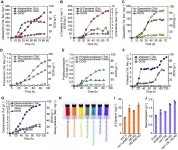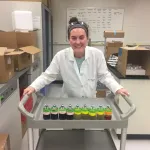The iron jaws of the bristle worm
Experiments at TU Wien (Vienna) show: Metal atoms are responsible for the remarkable stability of bristle worm jaws; this could be the key to new high-performance materials
2021-06-09
(Press-News.org) Bristle worms are found almost everywhere in seawater, they have populated the oceans for hundreds of millions of years. Nevertheless, some of their special features have only now been deciphered: Their jaws are made of remarkably stable material, and the secret of this stability can now be explained by experiments at TU Wien in cooperation with Max Perutz Labs.
Metal atoms, which are incorporated into the protein structure of the material, play a decisive role. They make the material hard and flexible at the same time - very similar to ordinary metals. Further research on this class of materials aims at producing novel, industrially usable materials in a natural way.
Individual metal atoms
"The materials that vertebrates are made of are well researched," says Prof. Christian Hellmich from the Institute of Mechanics of Materials and Structures at TU Wien. "Bones, for example, are very hierarchically structured: There are organic and mineral parts, tiny structures are combined to form larger structures, which in turn form even larger structures."
It's different with bristle worms. Their jaws are extremely strong and unbreakable, but they do not contain mineral granules like vertebrate bones do. Instead, they contain metals. Of course, this has nothing to do with pure metal objects such as gold teeth or artificial hips made of titanium: The bristle worm uses metals such as magnesium or zinc in the form of individual atoms that are incorporated into a protein structure.
"On its own, the fact that there are metal atoms in the bristleworm jaw does not explain its excellent material properties," says Christian Hellmich. The typical properties known from everyday metals - apart from their hardness and elasticity, above all their toughness - are ultimately only created through the interaction of many atoms. Sliding surfaces are created along which the atoms move against each other. This can be investigated with so-called nanoindentation tests: A force is exerted on the material in a precisely defined way and then the resulting deformations are studied. Surprisingly, it turned out that the material of the bristleworm jaw behaves very similarly to metal.
An ancient high-performance material
"The construction principle that has made bristle worm jaws so successful apparently originated about 500 million years ago," says Florian Raible of the Max Perutz Labs, a joint venture of the University of Vienna and the Medical University of Vienna. "The metal ions are incorporated directly into the protein chains and then ensure that different protein chains are held together." In this way, the bristle worm can produce three-dimensional shapes from a particularly stable protein matrix.
At the same time, this structure also allows for deformation: When an external force is exerted on the material, the protein chains can slide past each other. The material allows elastoplastic deformations, rather than being brittle and fragile.
"It is precisely this combination of high strength and deformability that is normally characteristic of metals," says Luis Zelaya-Lainez, the study's lead author, who used materials science techniques to examine the tiny jaws. "Here we are dealing with a completely different material, but interestingly, the metal atoms still provide strength and deformability there, just like in a piece of metal."
Whereas industrially manufactured metals can only be produced using a large amount of energy, the bristle worm achieves a similar feat in a much more efficient way. "Biology could serve as inspiration here, for completely new kinds of materials," Hellmich hopes. "Perhaps it is even possible to produce high-performance materials in a biological way - much more efficiently and environmentally friendly than we manage today."
INFORMATION:
The joint study between Hellmich's and Raible's working groups was made possible in part by support from the Austrian Academy of Sciences' "Research, Science and Society" innovation fund, which supports innovative basic research at the frontier of established research fields.
[Attachments] See images for this press release:

ELSE PRESS RELEASES FROM THIS DATE:
2021-06-09
X-rays are widely used to study the structures of various objects. New sources of x-rays, like Free Electron Lasers and 4th generation synchrotrons are being built around the Globe. The best optics for the new sources is usually made of the single crystal materials, such as silicon, germanium or diamond. However, the ideal periodicity of crystals leads to some unwanted diffraction losses - X-ray glitches. This effect causes dips in the intensity of the radiation transmitted through the optical element, down to zero. Scientists from the Immanuel Kant Baltic ...
2021-06-09
Language is one of our species' most important skills, as it has enabled us to occupy nearly every corner of the planet. Among other things, language allows indigenous societies to use the biodiversity that surrounds them as a "living pharmacy" and to describe the medicinal properties of plants. Linguists estimate that there are nearly 7,400 languages in the world today.
Most of these languages, however, are not recorded in writing, and many languages are not being passed on to the next generation. This has led linguists to estimate that 30 percent of all languages will disappear by the end of the 21st century. For indigenous cultures who mostly transmit knowledge orally, this ...
2021-06-09
A research group at KAIST has engineered bacterial strains capable of producing three carotenoids and four violacein derivatives, completing the seven colors in the rainbow spectrum. The research team integrated systems metabolic engineering and membrane engineering strategies for the production of seven natural rainbow colorants in engineered Escherichia coli strains. The strategies will be also useful for the efficient production of other industrially important natural products used in the food, pharmaceutical, and cosmetic industries.
Colorants are widely used in our lives and are directly related to human health when we eat food additives and wear cosmetics. However, most of these colorants are made from petroleum, causing unexpected side effects and health problems. Furthermore, ...
2021-06-09
Feelings of anxiety, pessimism and depression during the COVID-19 pandemic led middle-aged women in both Australia and the UK to stock up on alcohol, which was associated with drinking more, a new Flinders University-led study has found.
The research, led by Dr Emma Miller in Flinders University's College of Medicine and Public Health, also found women in the UK were more likely to drink at risky levels than their Australian counterparts during lockdown, and were more likely to have stockpiled alcohol.
Despite these differences, the research found the emotional responses to ...
2021-06-09
Tsukuba, Japan - Ceramic materials that are resistant to cracking are used in a variety of industries from aerospace engineering to dentistry. Toughening them to improve their efficiency and safety is therefore an important area of investigation. Researchers from the University of Tsukuba have used time-resolved X-ray diffraction to observe transformation toughening in zirconia ceramics during dynamic fracture. Their findings are published in Applied Physics Letters.
Current methods of observation allow the formation of cracks in materials to be observed in situ while loads are applied. These close-up analyses ...
2021-06-09
Human cells are kept healthy by the activity of millions of proteins. These proteins are modified in different ways, such as by adding sugar molecules to them, which can be crucial for them to function properly. Given this importance, defects in the sugar-adding process are often lethal at the very early stages of development. In rare cases, however, patients can develop sugar-adding deficiencies that result in a range of metabolic diseases, known collectively as 'congenital disorders of glycosylation' (CDG). These disorders are caused by defects in the enzymes involved in the sugar-adding process. For example, ALG2-CDG (or CDG-Ii) is a disorder caused by mutations in the ALG2 enzyme, ...
2021-06-09
MELVILLE, N.Y., June 9, 2021 -- Designing a soundscape to improve the quality of life for an individual is centered on putting their perception at the heart of the process. It becomes trickier for people who have diminished cognitive capacities.
During the 180th Meeting of the Acoustical Society of America, which will be held virtually June 8-10, Arezoo Talebzadeh, from Ghent University, will show how a personalized soundscape can help those with dementia by providing clues regarding time of day and place. The session, "Soundscape design for people with dementia; the correlation between psychoacoustic parameter and human perception," will take place Wednesday, June 9, ...
2021-06-09
UPTON, NY--How do you spot a subatomic neutrino in a "haystack" of particles streaming from space? That's the daunting prospect facing physicists studying neutrinos with detectors near Earth's surface. With little to no shielding in such non-subterranean locations, surface-based neutrino detectors, usually searching for neutrinos produced by particle accelerators, are bombarded by cosmic rays--relentless showers of subatomic and nuclear particles produced in Earth's atmosphere by interactions with particles streaming from more-distant cosmic locations. These abundant travelers, mostly muons, create a web of crisscrossing particle tracks that can easily obscure a ...
2021-06-09
Fruits, vegetables, red wine and chocolate are all rich in polyphenols, natural plant compounds that double as cancer-fighting antioxidants. We can access these foods' health benefits because the microbes in our guts happily feast on them, breaking them down into smaller chemical components.
Microbiome scientists at Colorado State University wanted to know if microbes can also break down those same polyphenols in systems outside the human body, including the microbial wild west of soils.
A research team led by Kelly Wrighton, associate professor in the College of Agricultural Sciences' Department of Soil and Crop Sciences, has uncovered new insights into the role of polyphenols in the soil microbiome, known as a black box for its complexity. They proffer an updated theory that soils ...
2021-06-09
Los Angeles (June 8, 2021) --
IBDs, including Crohn's disease and ulcerative colitis, are chronic conditions that occur when the intestinal immune system becomes overreactive, causing chronic diarrhea and other digestive symptoms. In a published survey at the beginning of COVID-19 vaccine distribution, 70% of IBD patients reported concern about side effects from the vaccines.
"What we've learned is that if you have IBD, the side effects you're likely to experience after a vaccine are no different than they would be for anyone else," said Gil Melmed, MD, corresponding author of the study and director of Inflammatory Bowel Disease Clinical Research at Cedars-Sinai. "If ...
LAST 30 PRESS RELEASES:
[Press-News.org] The iron jaws of the bristle worm
Experiments at TU Wien (Vienna) show: Metal atoms are responsible for the remarkable stability of bristle worm jaws; this could be the key to new high-performance materials







